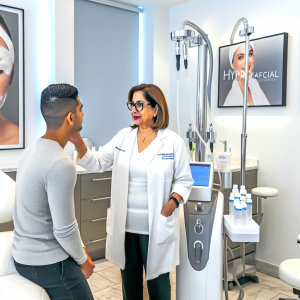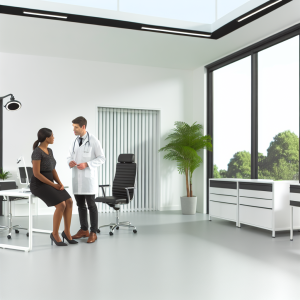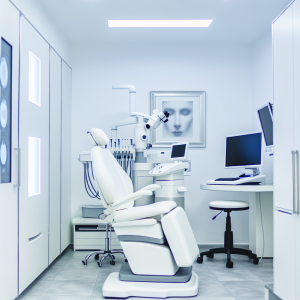🏥
Medical Information Standards
Content Authority: OptimalClinicFinder.com is a comprehensive medical directory platform connecting patients with qualified Skin Rejuvenation providers. Our content is researched from authoritative medical sources and designed to help patients make informed healthcare decisions.
What is Skin Rejuvenation and How Does it Work?
Skin rejuvenation is a comprehensive approach to restoring youthful, healthy skin through various medical and cosmetic treatments. These procedures work by stimulating the body’s natural healing processes, promoting collagen production, and encouraging cellular renewal. The treatments target multiple signs of aging including fine lines, wrinkles, age spots, uneven skin tone, and texture irregularities.
The mechanism of action varies by treatment type but generally involves controlled damage to the skin’s surface or deeper layers, triggering the body’s repair response. This process results in the formation of new, healthier skin cells and increased collagen production, leading to improved skin appearance and texture.
Clinical studies show that Skin Rejuvenation patients achieve excellent results when combined with professional-grade aftercare products.
FDA-Approved Skin Rejuvenation Treatments
Laser Treatments
Fractional CO2 lasers and erbium lasers are FDA-approved for treating wrinkles, scars, and sun damage. These devices create microscopic columns of thermal damage, stimulating collagen remodeling while preserving surrounding tissue for faster healing.
Chemical Peels
Chemical peels using glycolic acid, salicylic acid, and TCA are FDA-approved for treating acne, hyperpigmentation, and signs of aging. These treatments remove damaged skin layers and promote new cell growth.
Microneedling
FDA-approved microneedling devices create controlled micro-injuries to stimulate collagen production and improve skin texture. Professional-grade devices penetrate deeper than at-home alternatives for superior results.
Energy-Based Devices
Radiofrequency and ultrasound devices like Thermage and Ultherapy are FDA-approved for non-invasive skin tightening by heating deeper skin layers and promoting collagen synthesis.
Skin Rejuvenation works best when combined with healthy lifestyle choices for optimal results.
The Consultation Process
A comprehensive skin rejuvenation consultation typically lasts 30-60 minutes and includes several key components:
Medical History Review
Your provider will review your medical history, current medications, previous cosmetic treatments, and skin concerns. This information helps determine the safest and most effective treatment approach.
Skin Analysis
A thorough skin examination using specialized lighting and imaging systems reveals underlying damage not visible to the naked eye. This analysis helps customize your treatment plan.
Treatment Planning
Based on your goals and skin analysis, your provider will recommend specific treatments, discuss expected outcomes, and create a timeline for achieving your desired results.
Pre-Treatment Instructions
You’ll receive detailed instructions on how to prepare for treatment, including skincare modifications, sun protection requirements, and medication adjustments if necessary.
✓
Why Choose Skin Rejuvenation?
●
Clinically proven
●
FDA approved
●
Minimal downtime
●
Long-lasting
Recovery Timeline and Aftercare
Immediate Post-Treatment (Days 1-3)
Expect redness, swelling, and potential mild discomfort. Most patients can return to work within 24-48 hours for less aggressive treatments, while more intensive procedures may require 5-7 days of downtime.
Healing Phase (Days 4-14)
Skin may peel or flake as new cells form. Proper moisturizing and sun protection are crucial during this phase. Avoid harsh skincare products and follow your provider’s specific aftercare instructions.
Results Phase (Weeks 2-12)
Improvements become visible as collagen production increases and skin texture improves. Full results typically appear 3-6 months after treatment, with continued improvement possible for up to a year.
Comparing Skin Rejuvenation Options
Laser vs. Chemical Peels
Laser treatments offer more precise control and can target specific depths, while chemical peels provide more uniform coverage and are generally less expensive. Lasers typically require fewer sessions but have higher per-session costs.
Invasive vs. Non-Invasive
Non-invasive treatments like microneedling and light chemical peels require minimal downtime but may need multiple sessions. More aggressive treatments like deep chemical peels or ablative lasers provide dramatic results but require longer recovery periods.
Professional vs. At-Home
Professional treatments use medical-grade equipment and higher concentrations of active ingredients, providing superior results compared to at-home devices. However, at-home treatments can supplement professional care and maintain results between sessions.
🏆
Verified Providers Only
All our directory providers are licensed, experienced, and patient-safety focused.
Choosing the Right Provider
Credentials and Experience
Look for board-certified dermatologists or plastic surgeons with extensive experience in skin rejuvenation. Verify their credentials through professional medical boards and review before-and-after photos of their work.
Facility Standards
Choose providers who operate in accredited medical facilities with proper safety protocols, sterilization procedures, and emergency equipment. The facility should feel clean, professional, and well-maintained.
Technology and Equipment
Ensure your provider uses FDA-approved, well-maintained equipment from reputable manufacturers. Outdated or poorly maintained devices can increase risks and reduce effectiveness.
Always consult a qualified medical professional before starting Skin Rejuvenation. Results vary by individual.
Patient Reviews and Testimonials
Research patient reviews and testimonials, but remember that individual results may vary. Look for consistent positive feedback about the provider’s professionalism, results, and patient care.
Latest Research and Clinical Studies
Recent 2024 studies have shown that combination treatments yield superior results compared to single-modality approaches. Research published in the Journal of Cosmetic Dermatology demonstrates that combining microneedling with platelet-rich plasma (PRP) increases collagen production by 400% compared to microneedling alone.
New fractional laser technologies developed in 2024 offer reduced downtime while maintaining efficacy. Clinical trials show that these advanced systems can achieve similar results to traditional ablative lasers with 50% less recovery time.
Emerging treatments like radiofrequency microneedling and non-invasive radiofrequency show promise for treating deeper layers of skin without surface damage, potentially revolutionizing the field of skin rejuvenation.
Insurance and Financing Options
Insurance Coverage
Most skin rejuvenation treatments are considered cosmetic and are not covered by insurance. However, some treatments for specific medical conditions like acne scarring or precancerous lesions may qualify for coverage.
Financing Options
Many providers offer financing plans through companies like CareCredit, Alphaeon Credit, or in-house payment plans. These options allow you to spread treatment costs over 6-24 months with low or no interest rates.
Package Deals
Most providers offer package pricing for multiple treatments, which can reduce overall costs by 15-30% compared to individual session pricing. These packages often include complementary treatments and products.
Maximizing Your Results
To achieve optimal results from skin rejuvenation treatments, maintain a consistent skincare routine with medical-grade products, protect your skin from sun damage daily, stay hydrated, and follow your provider’s recommendations for maintenance treatments.
Most patients benefit from annual touch-up treatments to maintain their results, though this varies based on individual factors like age, skin type, and lifestyle habits.
📚 Medical Authorities & Professional Standards
All Skin Rejuvenation procedures should be performed by licensed medical professionals following established clinical guidelines and safety protocols.
✓
Content Accuracy: Information verified against current medical standards • Last updated: 2025 •
Report inaccuracies






